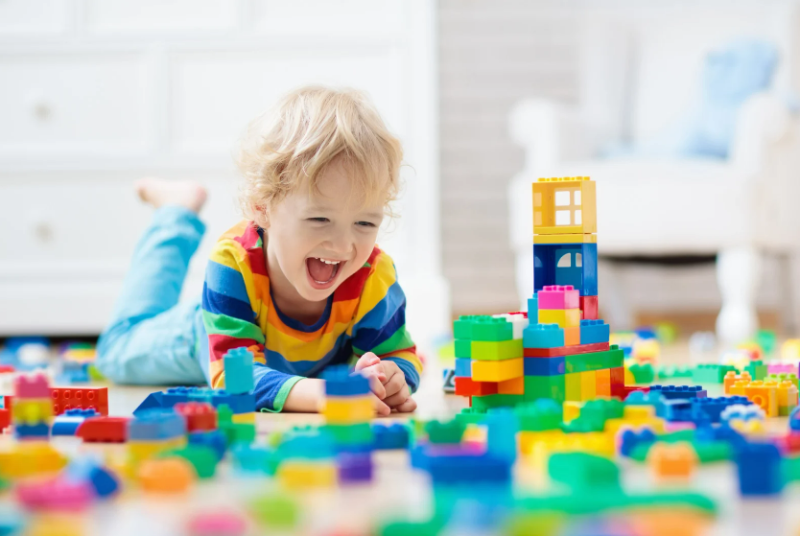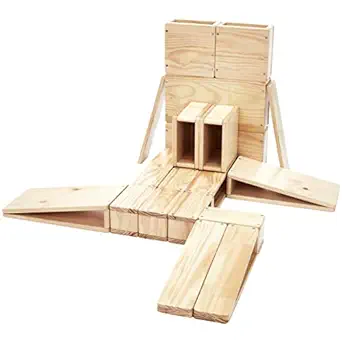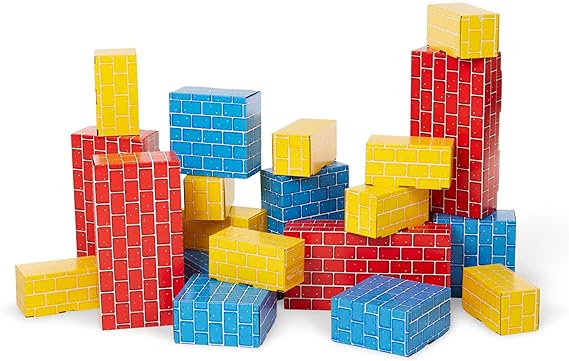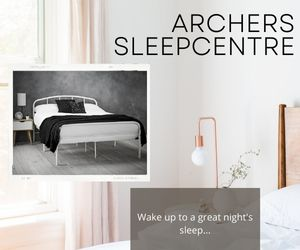
Kids Building Blocks Toys

When it comes to kids building blocks toys are about as educational and fun as they can get. Children can spend hours building castles, cities, houses, and roads, using only this simple toy and their imaginations. From wooden unit blocks to huge cardboard versions, the varieties are nearly endless.
Check out these kids building blocks toys on Amazon
Unit Blocks
Unit blocks are wooden blocks that follow a pattern in their sizes. Typically, the longest size is about a foot long by about four inches wide. Then there are blocks that are half this length, a quarter of this length, and an eighth of this length. Because of their sizes, unit blocks are great for learning math, and they’re also just plain fun to use in building. These blocks are ideal for children from three to eight years old. The heavy weight of these wood blocks and the small size of some of the pieces make them inappropriate for younger children.

Amazon Basics Over-Sized Hollow Wooden Building Block Set for Kids
Melissa and Doug Standard Unit Blocks are a great option, since they come with their own storage crate. They are constructed of durable hardwood and will last for many years. Lakeshore Learning also offers a huge, deluxe set of hardwood unit blocks, complete with a 50-year guarantee. This set features a number of arches and columns for making interesting architectural constructions.
Alphabet Blocks
Alphabet blocks are some of the most common childhood toys, and they’ve been popular for generations. These blocks feature letters on some sides and pictures on others. Children can use them to build structures, learn stacking, or even begin to read and spell. These blocks come in a variety of materials, including wood, plastic, and foam. They are a versatile, fun toy right from the start. If you’re considering buying alphabet blocks for a baby, make sure the size of the blocks is large enough to prevent them from being a choking hazard.

ABC Wooden Building Blocks for Toddlers 1-3 Large on Amazon
Foam Blocks
While wood blocks have a classic appeal, they can be heavy and noisy. If you’re looking for something a little softer, foam is a great alternative. Foam blocks come in bright, attractive colors, and they have no sharp edges or splinters. They’re also quieter when knocked down and light enough for little hands to lift them. These blocks come in a wide range of sizes. Typically, the size of this type of block will dictate the appropriate age range. For babies, stick to sets with larger blocks.

Foam Building Blocks for Toddlers 1-3 on Amazon
Sensory Edge has a deluxe set of durable foam blocks which includes arches, columns, and a number of other fun shapes. They come with their own storage bag and are best for kids over the age of three. The Creativity Institute offers a set of jumbo foam blocks that are fun for babies and toddlers. These blocks are brightly-colored and big enough for kids to climb over.
Plastic Blocks
Plastic blocks, which often feature interlocking parts, are fun toys to build for preschoolers and older children. The size of the blocks will dictate the age of the child, since it’s easier for little hands to manage larger blocks. Small blocks allow older kids to construct elaborate structures.

Toy Building Blocks for Toddlers 1-3 on Amazon
Lego has a long history of producing quality children’s blocks, and sets like the Lego Kingdom encourage fine motor skills and pretend play. Younger kids can enjoy Duplo products as well.
Cardboard Blocks
Durable and inexpensive, cardboard building blocks are another fun option. These blocks are typically large in size, allowing kids to create structures and interact with those structures using their whole bodies. They’re perfect for making tunnels, forts, or pretend houses. Light enough that kids won’t get hurt if their structures collapse, these blocks are perfect for kids two years and older.

Melissa & Doug Jumbo Extra-Thick Cardboard Building Blocks on Amazon
Melissa and Doug Jumbo Cardboard Blocks are a great choice, especially since they come in bright primary colors. Lillian Vernon has a great set of cardboard blocks, available in primary or pastel colors. There’s also an expansion set of architectural pieces to add to your basic blocks.
Learning Upon Playing
With so many types of block sets available, parents may wonder what to buy. Because most blocks are so sturdy and can be passed down from child to child, there’s no reason not to buy several different kinds. Start with fabric blocks that teach colors and then move onto wooden blocks, with letters and without, to encourage letter recognition, reading, and imaginative play. Children can enjoy blocks from before they’re walking long into their school years.


